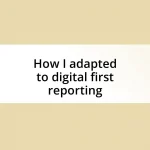Key takeaways:
- Audience analytics reveal valuable insights about preferences and behaviors, challenging assumptions about content delivery.
- Engagement metrics, such as engagement rate and average time on page, are essential for understanding audience connection and refining content strategy.
- Incorporating diverse feedback and trends allows for continuous improvement and enhanced audience relationships through tailored content experiences.
- Utilizing tools like Google Analytics and audience surveys helps create richer, more relatable content by aligning it with audience needs and interests.
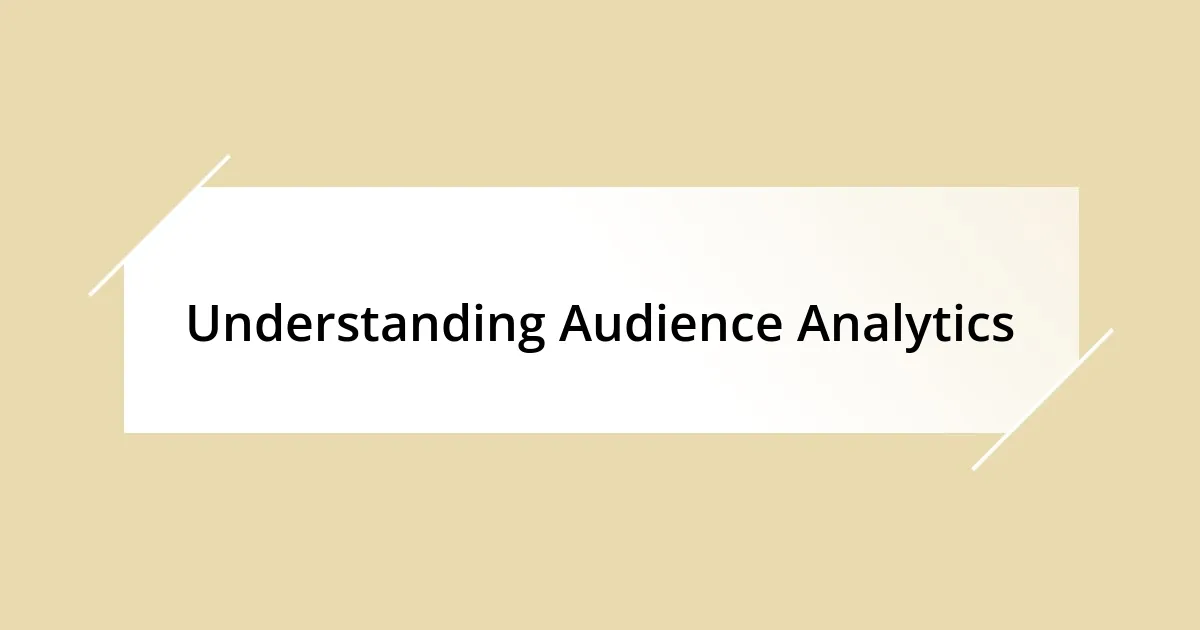
Understanding Audience Analytics
Understanding audience analytics isn’t just about numbers; it’s about the stories those numbers tell. When I first delved into analytics, I was amazed by how one metric could reveal so much about preferences, behaviors, and the emotional connection users have with content. I still remember analyzing data from a recent campaign and discovering that a simple graphic evoked far more engagement than I had anticipated—why did that happen?
As I navigated through audience demographics, I learned the importance of tailoring content to meet different needs. For instance, I once assumed a younger audience would prefer fast-paced videos, but the data showed they craved in-depth tutorials instead. This insight was not only surprising but also transformative; it made me rethink my entire content strategy and approach.
In reflecting on audience analytics, I often wonder: how many opportunities for connection do we overlook simply because we rely on assumptions? This question drives me to dig deeper into the analytics, examining what resonates on a personal level. Each insight gained from these metrics has not only shaped my projects, but has also reinforced the fact that understanding my audience is truly a journey worth taking.
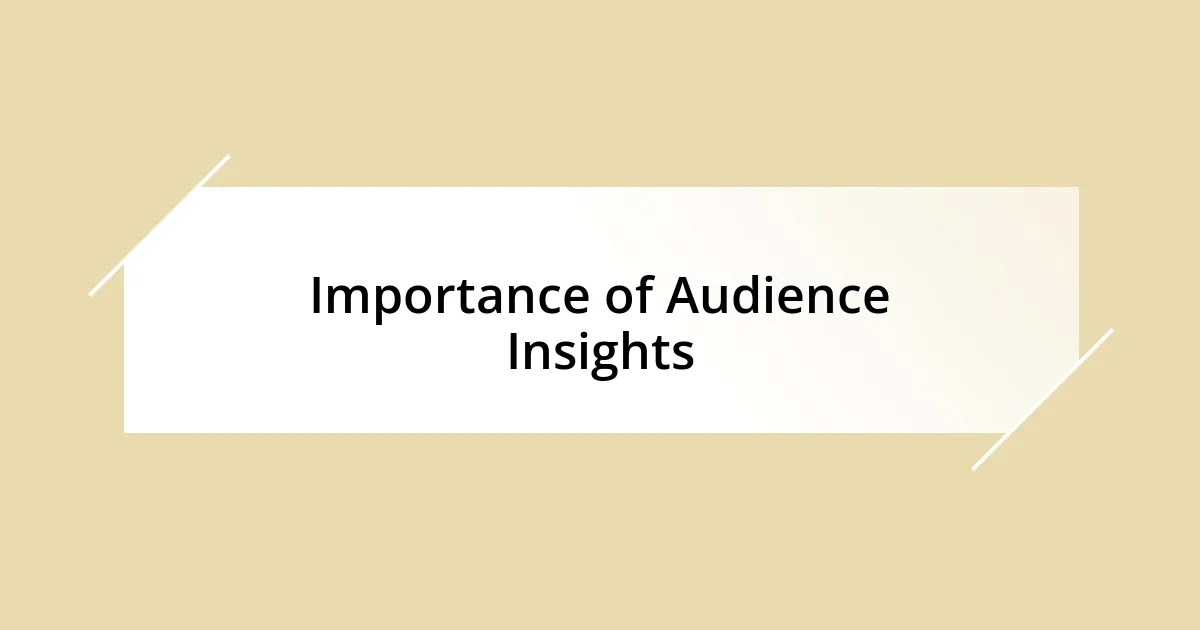
Importance of Audience Insights
Understanding the importance of audience insights has been a pivotal aspect of my growth in content creation. I recall a time when I dismissed feedback from a small segment of my audience, thinking their preferences didn’t matter. However, later analysis revealed that this group had a unique perspective that could have enriched my work. It taught me that every voice counts, and these insights can lead to significant improvements in how content is developed and delivered.
Moreover, audience insights help me identify trends that I might overlook. For example, during a project, I noticed a spike in engagement when I used relatable storytelling rather than just presenting facts. This realization pushed me to incorporate more personal anecdotes in my writing, making my content resonate on a deeper level. That emotional connection can be the difference between a fleeting visit and a loyal follower.
Lastly, authentic insights bring clarity to my creative process. I’ve had instances where I thought a piece would perform well, but the analytics told a different story. It’s a humbling experience, but I appreciate how it redirects my focus toward what truly matters to my audience. By understanding their motivations and preferences, I can craft experiences that not only meet their expectations but sometimes exceed them entirely.
| Key Aspect | Impact of Audience Insights |
|---|---|
| Diverse Feedback | Incorporating all voices enhances content richness. |
| Trend Identification | Spotting patterns leads to more engaging storytelling. |
| Creative Clarity | Refines focus towards audience needs, improving performance. |
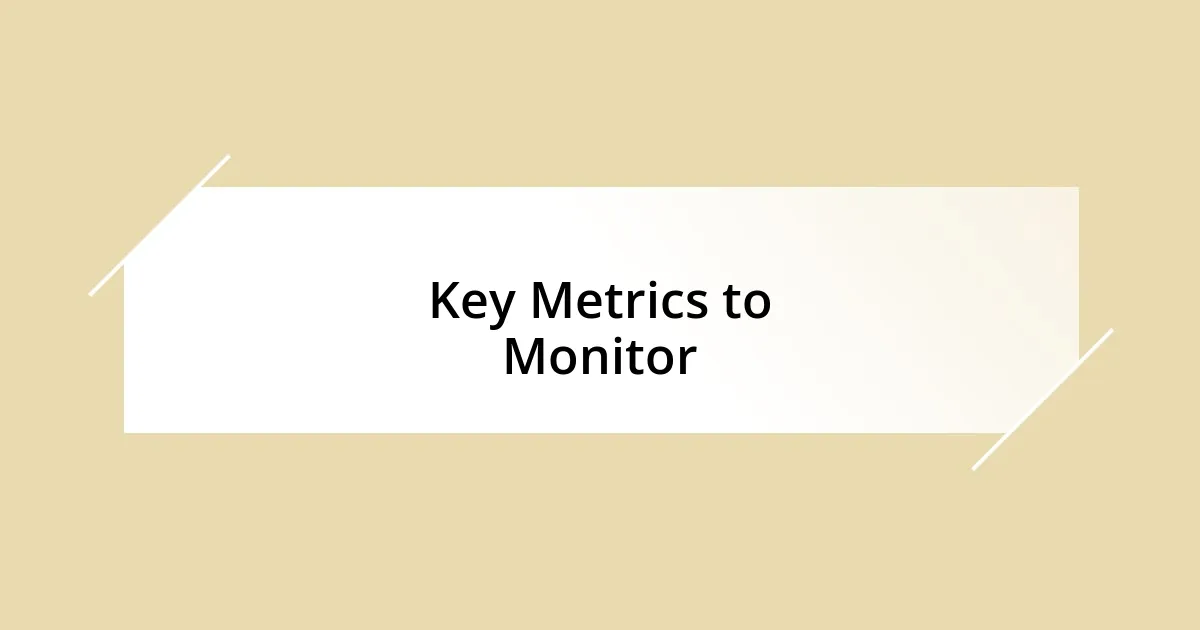
Key Metrics to Monitor
Monitoring key metrics is essential for understanding audience behavior. I once focused heavily on just likes and shares, only to realize that these numbers didn’t capture the full picture. The real gold lies in metrics such as engagement rates and time spent on certain content. These indicators helped me uncover what truly resonates with my audience, steering my strategy in unexpected yet enriching directions.
Here are the key metrics I always keep an eye on:
- Engagement Rate: Measures interactions relative to total reach; a deeper indicator of audience interest.
- Click-Through Rate (CTR): Shows how effective your call-to-action is in motivating users.
- Average Time on Page: Indicates whether your content keeps the audience engaged.
- Bounce Rate: Reveals the percentage of visitors who leave without interaction; high rates can signal a need for content adjustment.
- Demographic Information: Understanding the age, gender, and location of your audience helps tailor content effectively.
Each metric offers a unique lens through which I can evaluate my content’s performance. Recently, I noticed a high bounce rate on a articles I believed would be well-received. After examining the data, I discovered my headline was misleading—it drew readers in, but the content didn’t deliver what they expected. This insight pushed me to reevaluate my approach, ensuring that my content aligns closely with audience expectations and interests.
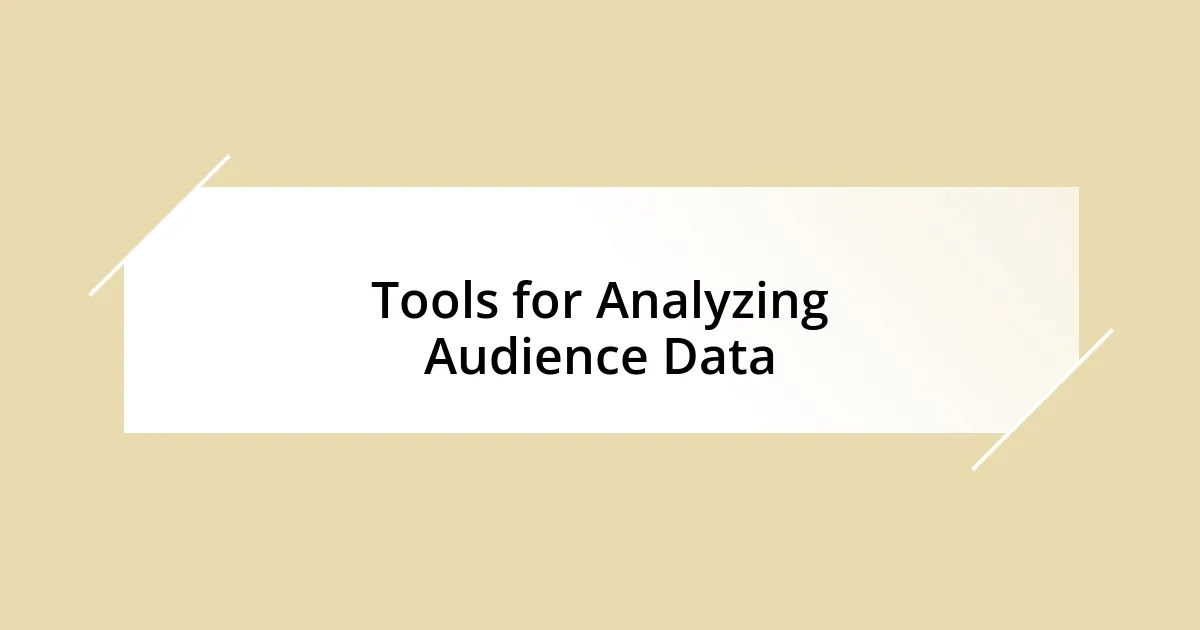
Tools for Analyzing Audience Data
When it comes to analyzing audience data, several tools have become staples in my toolkit. For instance, Google Analytics has been a game changer for me—it’s not just about the numbers, but what those numbers mean. I remember the first time I used it; I noticed that my audience was spending more time on certain blog posts than I had thought. It felt exhilarating to realize I was starting to understand my readers’ preferences on a much deeper level.
Another essential tool in my analysis arsenal is social media analytics. Platforms like Facebook and Instagram offer valuable insights into audience demographics and engagement rates. I had a moment of realization when I posted a photo that received unexpected engagement. The analytics revealed that my audience was particularly responsive to behind-the-scenes content. This prompted me to dive deeper into that type of sharing, enriching my communication with followers in a way that felt genuine and relatable.
Don’t forget about audience surveys—they’re often overlooked but offer rich qualitative data. I once sent out a simple questionnaire to my readers asking what topics they wanted to see next. The responses were enlightening, shaping my content calendar in ways I hadn’t anticipated. Have you ever struggled to find inspiration? Engaging directly with your audience can not only guide your content but also deepen the connection you share with them.

Interpreting Audience Behavior Trends
When interpreting audience behavior trends, I’ve found it’s crucial to not just glance at the data but to dig deeper into what those numbers are telling me. For example, I once observed that a particular video tutorial had sky-high engagement but relatively low shares. It made me wonder: why were viewers loving the content but hesitant to share it? This prompted me to tweak the messaging, making it clearer how sharing could tangibly benefit them, and in turn, my audience became more inclined to pass it on.
Another instance involves analyzing scrolling behavior on my blog. One day, I noticed that readers would scroll through an article but drop off just before the conclusion. This was perplexing at first—was the content uninteresting, or were they just tired? After some trial and error with different layouts and summaries, I found that a concise recap at the end helped retain their attention, allowing me to deliver on the promise I made at the start. Isn’t it amazing how a small change can lead to significant improvements in audience retention?
Sometimes, I feel that the shifts in audience behavior can be emotionally revealing. Recently, I launched a campaign inspired by a trending topic. At first, the likes came pouring in, but then I noticed a sharp drop in interaction. This inconsistency made me reflect: Was I simply hopping on the bandwagon, or was I truly connecting with my audience? It was a good reminder that resonance goes beyond metrics; it’s about creating content that genuinely speaks to my audience’s experiences and feelings. What are your observations in your content journey? Understanding these behavior trends can transform not just how I publish, but how I connect.
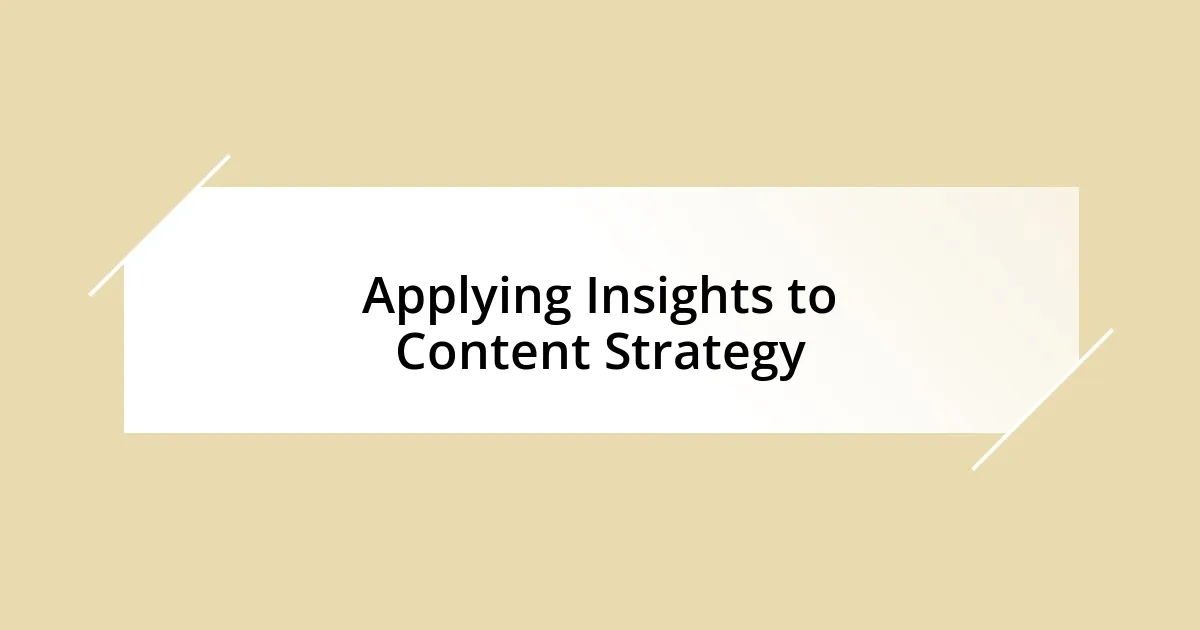
Applying Insights to Content Strategy
Applying audience insights to my content strategy has been nothing short of transformative. I remember a specific instance where analytics revealed that my articles on wellness tips were attracting a younger audience than I anticipated. This insight nudged me to pivot my content towards more trendy, accessible approaches like quick, bite-sized videos and Instagram stories. Have you ever considered how small adjustments might resonate differently with various age groups?
Moreover, understanding audience preferences led me to experiment with different content formats. After observing that my infographics consistently received higher shares, I decided to dedicate more time to visually engaging content. It was exhilarating to see the numbers reflect my efforts—higher engagement not only boosted my confidence but also reinforced the value of creativity in my messaging. Isn’t it remarkable what happens when you align your strengths with your audience’s interests?
Finally, I’ve started to embrace a more iterative approach to my content strategy. Using feedback loops—like incorporating polls after webinars—has allowed me to actively involve my audience in shaping future topics. I recall one poll about preferred content themes that surprised me: my audience was craving deep-dives into mental health rather than lighthearted tips. This experience taught me that listening to my audience isn’t just about data; it’s about creating a collaborative space where their voices help steer the conversation. How often do you engage your audience in crafting your content journey? This collaboration has not only deepened my connection with them but also enriched the authenticity of my content.
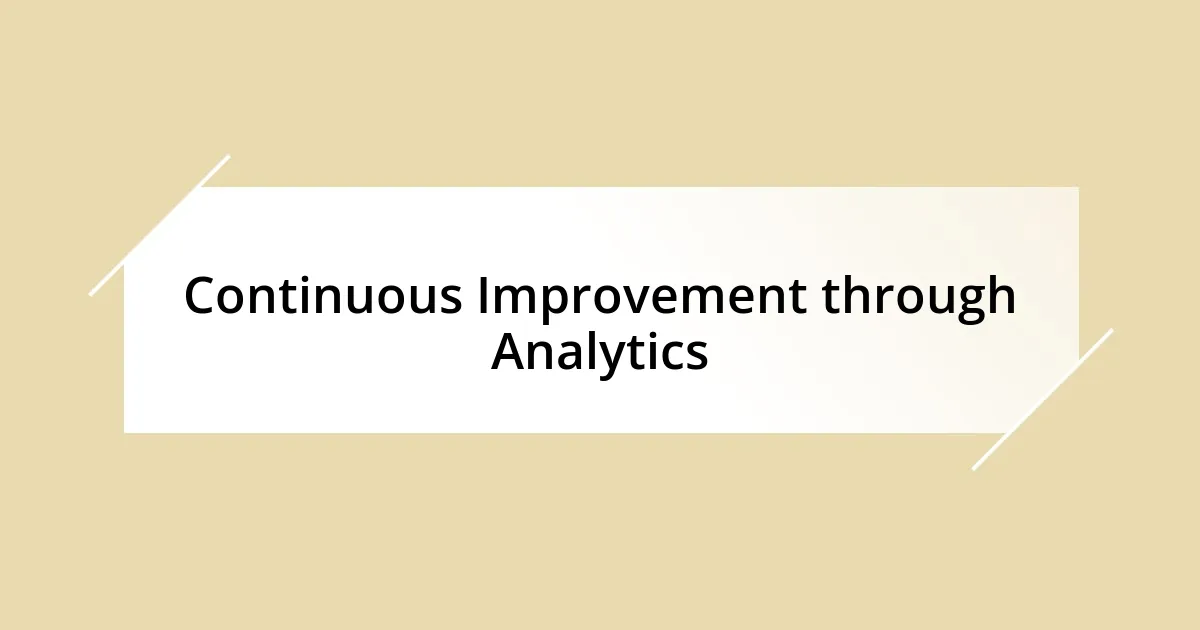
Continuous Improvement through Analytics
Continuous improvement through analytics has become a game-changer in my content creation process. For example, I once noticed a trend where my blog posts that included personal stories received much higher engagement than technical pieces. This realization nudged me toward embracing vulnerability in my writing. It’s fascinating to think about how sharing authentic experiences can foster deeper connections, don’t you think?
Additionally, I’ve experimented with A/B testing on my newsletter subject lines. One time, I tried two vastly different approaches: one was straightforward, while the other was playful and intriguing. The latter not only garnered more opens but also led to an uptick in click-through rates. It was a thrilling moment that reaffirmed my belief in the power of curiosity as a driving force for engagement. Have you ever tested different approaches to see what resonates? Such moments highlight the importance of continually refining strategies based on audience response.
By consistently monitoring important metrics like bounce rates and session duration, I’ve been able to identify which content truly captivates my audience. I distinctly remember a period when I pivoted my focus toward more in-depth tutorials after realizing that readers would linger longer on those pages. The rush of feedback was invigorating; I felt validated in my efforts to provide valuable insights. Isn’t it empowering to see how data can guide us to create content that resonates more deeply? This continuous cycle of improvement truly keeps the creative juices flowing!













